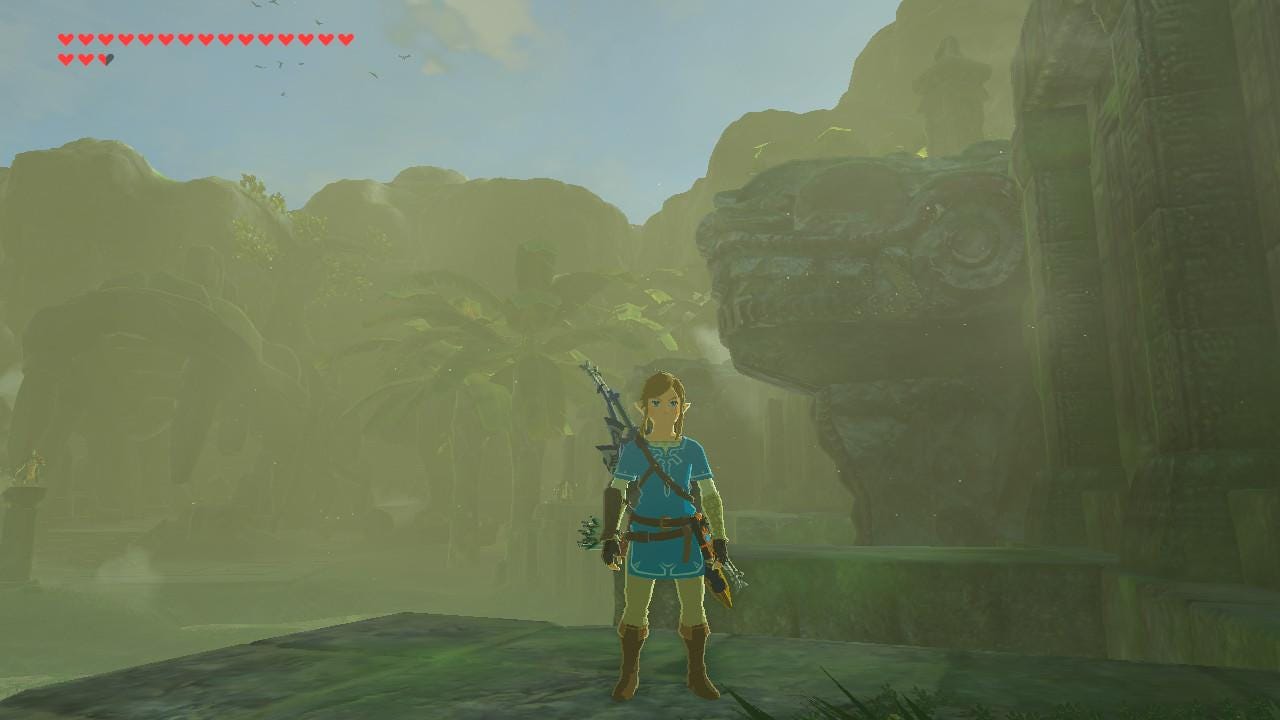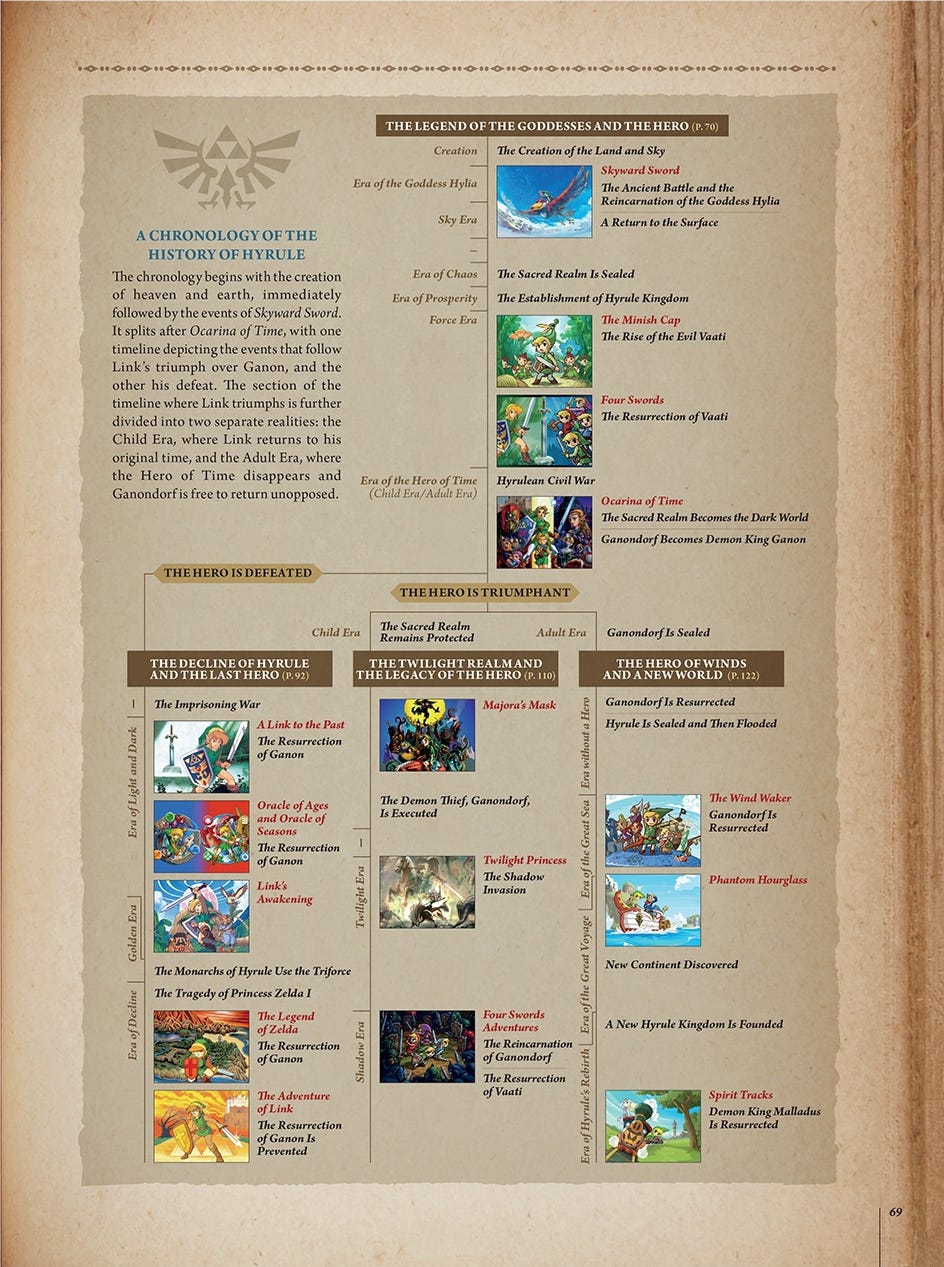How to Build a World like Breath of the Wild
Giving your TTRPG worlds a mysterious, storied history.
Welcome to the first post in my new series: How to Build a World Like… Each post will examine a piece of media (mostly games), see what makes their fictional settings so great, and hopefully find some useful insights that can inform the worldbuilding in my own games. We’re kicking off with one of my favourite video games of all time: The Legend of Zelda: Breath of the Wild.
Breath of the Wild’s Hyrule is one of my favourite game worlds. It feels historic and alive in a way nothing else I’ve played ever has. The world is full of mysteries, some built on the franchise’s history, others completely new, but all of which make the world fascinating to explore for both series veterans and newcomers alike. Personally, Breath of the Wild was my first proper foray into the Zelda series, but each game I’ve played since has given me a new sense of appreciation for this latest version of Hyrule.
Today I want to go through the eras of Hyrule's history leading up to Breath of the Wild, discuss what each one contributes to the story and gameplay, and see how that can inform worldbuilding for TTRPGs.
100 Years Ago - The Last Great Calamity
100 years ago, Ganon erupted from beneath Hyrule Castle in an event known as a Great Calamity. Link, Zelda and the four Champions fought against Calamity Ganon, but were defeated. Link retreats and is kept in stasis until the start of the game, when Ganon’s power is growing once more.
Calamity Ganon erupting from Hyrule Castle
During the fight, the Divine Beasts and Guardians, magic technology created to fight Ganon in the past, were possessed and turned against the Hylian forces. Ganon’s other minions - Bokoblins, Moblins, Lizalfos and Lynels - were also summoned during this time.
This is the moment in Hyrule’s history where the present state of the world is established. It sees the creation of most of the game’s enemies, and defines the main objectives of the game: free the Divine Beasts and defeat Ganon. Setting this event 100 years ago and having Link absent from the last century gives a reason to explain things to the player, since the player character is just as unfamiliar with the world as the player is.
10,000 Years Ago - The First Great Calamity
10,000 years ago saw the occurrence of another Great Calamity, where Ganon arose from beneath Hyrule Castle for the very first time. During this period, the Shiekah created the Divine Beasts and Guardians to fight off Ganon, as well as the Shrines, small puzzles found across the land to test future heroes that would fight Ganon.

In game, both the Shrines and Divine Beasts act as dungeons that the player can complete. This era narratively justifies the existence of these dungeons, giving them a believable place in the world. This does, however, come at the cost of making the dungeons all look incredibly similar, which is one of the few major criticisms frequently lobbied against Breath of the Wild. If you want to have all your world’s dungeons come from the same era, consider making an effort to give each one a distinct aesthetic, so you don't fall into the same trap Breath of the Wild did.
In the real world, the entirety of recorded human history only goes back about 5,000 years. But 10,000 years in, we're only halfway through the eras of Hyrule!
Before that - The Rise and Fall of the Zonai
An unknown amount of time before the First Great Calamity, there was a kingdom of people known as the Zonai. While the Zonai are given a much greater presence in the game’s sequel, in Breath of the Wild the Zonai were a mysterious civilisation who's only remaining presence in the world is the ruins of their civilisation.
Spread throughout Hyrule are a number of ruins and labyrinths bearing mesoamerican-style depictions of dragons, owls and boars, three common animal motifs across the franchise. One of these is named the Zonai Ruins, but many others bear the same architectural styles.
In the art book Creating a Champion, which outlines much of the design process behind Breath of the Wild, Senior Lead Artist Makoto Yonezu says of the Zonai, “we thought that if we showed fragments of a civilization that collapsed long ago, it would make the world feel more real. That's why we added Zonai relics throughout Hyrule.”
The fact that an entire civilisation rose and fell in the history of this place, and that it's not in any way related to the plot of the game, makes the world feel historic and more believable, rather than feeling like it was built purely to facilitate the player and their story.
If you want to do this yourself, you don't even need to give that many details. We basically only knew 3 things about the Zonai in Breath of the Wild: their name, their style of architecture, and that the Barbarian armour set could be found in their labyrinths. That was enough to create mystery that the developers could then expand on and turn into a focus of the sequel (or the next arc of your campaign!).
Before THAT - Every Other Zelda Game
Finally, before everything else we've spoken about so far, the events of every other Zelda game that was previously released occured. Up until Breath of the Wild, the Zelda timeline was split into 3 paths because of weird time travel shenanigans in Ocarina of Time.
But having to worry about where each game fit onto the timeline was starting to become a problem for the design team. In an interview with IGN, series director Eiji Aonuma says “I don't like to put too much stock in the chronology of the series, because from the design perspective, that can kind of box us in.”
In an effort to free themselves from the constraints of the timeline, the Breath of the Wild developers decided to set the game so far into the future, that every timeline could eventually lead to Hyrule in this state, effectively merging the branches back together.
Because of this merge, Breath of the Wild is able to reference events, places and characters from over a dozen other stories. It’s a powerful feeling to recognise something from a previous game and see how it has changed over the millennium. It can be awe-inspiring or tragic…

Now, you probably don’t have nearly 40 years of worldbuilding to reference in your games, but you can recreate this feeling by involving your players in building out the history of the world instead. I once ran a D&D campaign set after a great flood, where the cities had built giant domes to survive underwater. Before the campaign, I ran a level 20 oneshot where the players played champions of the world trying to save civilians before the flood came. Then, in the campaign, I placed a monument to these champions in the centre of the city, and eventually gave the party some of the champions’ magic items as loot. These were great moments for the players, they were able to feel like they had a massive impact on the world, and that their historic decisions had affected the current story. Similar effects could be achieved by prefacing your campaign with a game of Microscope, or by using Daggerheart’s new collaborative worldbuilding system.
Letting all the players contribute to your world’s lore simultaneously makes them more engaged in the setting and takes some work off the GM’s back as well, it’s a win-win!
Conclusion
Overall, Breath of the Wild’s eras contribute 4 separate things to the setting:
They establish the current state of the world
They justify historical places and objects
They allude to ancient history, which makes the world feel more believable
They get the player invested by showing them places they’ve previously experienced through the eyes of other characters
If you’d like to learn more about how Breath of the Wild’s world feels so ancient, I would definitely recommend The Eternal Hyrule by Overly Sarcastic Productions on YouTube. And if you want to learn a super quick and practical way to represent the eras of your TTRPG world in game, check out Thomas Manuel’s Layering History Like Elden Ring on the Indie TTRPG Newsletter, which applies much of what I discussed here to 2023’s other, massive, open-world, fantasy video game!
Thanks for reading! I hope you got something useful out of this, I’d really appreciate it if you shared this post and subscribed to Jackalope Mail if you haven’t already! And let me know if there are anything you’d like to see me cover in this series!
See you next month!
CJ




